Geography of the European Netherlands
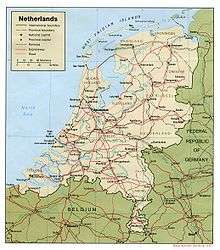
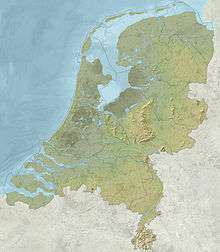
The geography of the Netherlands in Europe is unusual in that much of its land has been reclaimed from the sea and is below sea level, protected by dikes. Another factor that has influenced its physical appearance is that the country is among the most densely populated on Earth. It is ranked 30th overall on that scale, but is behind only three countries having a population over 16 million. Consequently, the Netherlands is highly urbanized.
Landscape
The European part of the country can be split into two areas: the low and flat lands in the west and north, and the higher lands with minor hills in the east and south. The former, including the reclaimed polders and river deltas, make up about half of its surface area and are less than 1 metre (3.3 ft) above sea level, much of it actually below sea level. An extensive range of seawalls and coastal dunes protect the Netherlands from the sea, and levees and dikes along the rivers protect against river flooding. The rest of the country is mostly flat; only in the extreme south of the country does the land rise to any significant extent, in the foothills of the Ardennes mountains. This is where Vaalserberg is located, the highest point on the European part of the Netherlands at 322.7 metres (1,059 ft) above sea level. The highest point of the entire country is Mount Scenery (887 metres or 2,910 ft), which is located outside the European part of the Netherlands, on the island of Saba.
Statistics
Geographic coordinates: 5.45°E and 50.30°N
- 1 degree = 111 km NS, 68 km EW (the ratio is 0.61, the cosine of the latitude)
- 1 minute = 1,850 m NS (ca. 1 nautical mile), 1,140 m EW
- 1 second = 31 m NS, 19 m EW
The Dutch RD coordinate system (Rijksdriehoeksmeting) is also in common use; see (pdf, in Dutch; see little map on p. 1) and converter. There is a west-east coordinate between 0 and 280 km, and a south-north coordinate between 300 and 620 km.
The reference point is the Onze-Lieve-Vrouwentoren (Our Lady's Tower) in Amersfoort, with RD coordinates (155.000, 463.000) and geographic coordinates approximately 52°9′N 5°23′E / 52.150°N 5.383°E.
Rate of change of solar time: 1 minute per 17 km EW.
Highest altitude of the Sun varies at the center from 38.5 − 23.5 = 15 degrees in December to 38.5 + 23.5 = 62 degrees in June. This occurs, depending on east-west location, at ca. 11:40 UTC, i.e. local time 12:40 in winter and 13:40 in summer.
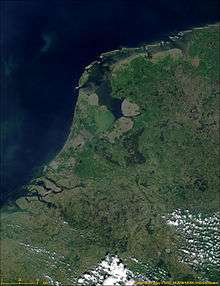
Map references: Europe
Area:
total: 41,543 km2 (16,040 sq mi)
land: 33,893 km2 (13,086 sq mi)
water: 7,650 km2 (2,954 sq mi)
Land boundaries:
total: 1,027 km (638 mi)
border countries:
Coastline: 451 km (280 mi)
Maritime claims:
territorial sea: 12 nmi (22.2 km; 13.8 mi)
continguous zone: 24 nmi (44.4 km; 27.6 mi)
exclusive fishing zone: 200 nautical miles (370.4 km; 230.2 mi)
Climate: temperate; marine; cool summers and mild winters (European mainland), tropical (Caribbean islands)
Terrain: mostly coastal lowland and reclaimed land (polders); some hills in southeast
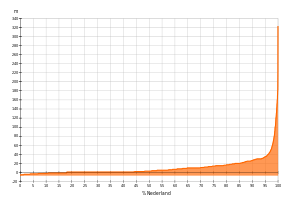
Elevation extremes:
lowest point: Zuidplaspolder (Nieuwerkerk aan den IJssel) −7 m (−23 ft), below sea level.
highest point on European mainland: Vaalserberg 322.7 m (1,059 ft) above sea level.
highest point (including the Caribbean islands): Mount Scenery on Saba 887 m (2,910 ft) above sea level.
Natural resources: natural gas, petroleum, peat, limestone, salt, sand and gravel, arable land
Land use: (2011)
arable land: 25.08%
permanent crops: 0.88%
other: 74.04%
Irrigated land (2007): 4,572 km2 (1,765 sq mi)
Total renewable water resources (2011): 91 km3 (22 cu mi)
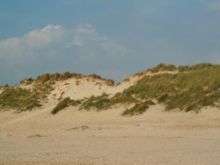
Natural hazards: flooding by sea and rivers is a constant danger. The extensive system of dikes, dams, and sand dunes protect nearly one-half of the total area from being flooded during the heavy autumn storms from the north-west.
Environment – current issues: water pollution in the form of heavy metals, organic compounds, and fertilisers such as nitrates and phosphates; air pollution from vehicles and refining activities; acid rain
Environment – international agreements:
party to:
Air Pollution, Air Pollution-Nitrogen Oxides, Air Pollution-Persistent Organic Pollutants, Air Pollution-Sulphur 85, Air Pollution-Sulphur 94, Air Pollution-Volatile Organic Compounds, Antarctic-Environmental Protocol, Antarctic Treaty, Biodiversity, Climate Change, Climate Change-Kyoto Protocol, Desertification, Endangered Species, Environmental Modification, Hazardous Wastes, Law of the Sea, Marine Dumping, Marine Life Conservation, Ozone Layer Protection, Ship Pollution, Tropical Timber 83, Tropical Timber 94, Wetlands, Whaling
signed, but not ratified:
none of the selected agreements
Geography – note: located at mouths of three major European rivers (Rhine, Maas or Meuse, and Scheldt)
Urbanization
Largest cities
Sources are CBS based
see ; and [1]
with their provinces in 2006:
- Amsterdam (North Holland) 744,740 inhabitants
- Rotterdam (South Holland) 581,615 inh.
- The Hague ('s-Gravenhage) (South Holland) 474,245 inh.
- Utrecht (Utrecht) 290,529 inh.
- Eindhoven (North Brabant) 209,601 inh.
- Tilburg (North Brabant) 200,975 inh.
- Almere (Flevoland) 181,990 inh.
- Groningen (Groningen) 180,824 inh.
- Breda (North Brabant) 170,451 inh.
- Nijmegen (Gelderland) 160,732 inh.
- Apeldoorn (Gelderland) 155,328 inh.
- Enschede (Overijssel) 154,311 inh.
- Haarlem (North Holland) 147,179 inh.
- Arnhem (Gelderland) 142,638 inh.
- Zaanstad (North Holland) 141,829 inh.
- Amersfoort (Utrecht) 139,914 inh.
- Haarlemmermeer (municipal seat: Hoofddorp) (North Holland) 139,396 inh.
- 's-Hertogenbosch (North Brabant) 135,787 inh.
- Zoetermeer (South Holland) 118,534 inh.
- Dordrecht (South Holland) 118,443 inh.
- Maastricht (Limburg) 118,378 inh.
- Leiden (South Holland) 117,363 inh.
- Zwolle (Overijssel) 124,032 inh.
- Ede (Gelderland) 107,528 inh.
- Venlo (Limburg) 100,271 inh.
- Westland (municipal seat: Naaldwijk) (South Holland) 99,067 inh.
- Deventer (Overijssel) 96,958 inh.
- Sittard-Geleen (municipal seat: Sittard) (Limburg) 96,024 inh.
- Delft (South Holland) 95,237 inh.
- Alkmaar (North Holland) 93,986 inh.
Largest agglomerations
Sources are based on CBS see and [1]
- Amsterdam (Amsterdam, Amstelveen, Diemen, Landsmeer, Oostzaan, Wormerland, Zaanstad)
- Rotterdam (Rotterdam, Barendrecht, Capelle aan den IJssel, Krimpen aan den IJssel, Spijkenisse, Schiedam, Vlaardingen, Maasland, Maassluis, Rozenburg)
- The Hague ('s-Gravenhage, Rijswijk, Wateringen, Voorburg, Leidschendam, Wassenaar)
- Utrecht (Utrecht, Nieuwegein, IJsselstein, Maarssen)
- Eindhoven (Eindhoven, Veldhoven, Geldrop, Son en Breugel, Waalre)
- Breda (Breda, Oosterhout, Etten-Leur, Drimmelen, Zundert)
- Tilburg (Tilburg, Goirle)
- Haarlem (Haarlem, Heemstede, Bloemendaal)
- Twente (Enschede, Hengelo, Borne, Almelo)
- Groningen (Groningen, Haren)
- Arnhem (Arnhem, Rozendaal)
- Leiden (Leiden, Voorschoten, Leiderdorp, Oegstgeest)
- Dordrecht (Dordrecht, 's-Gravendeel, Hardinxveld-Giessendam, Papendrecht, Sliedrecht, Zwijndrecht)
- Heerlen (Heerlen, Kerkrade, Landgraaf, Brunssum)
- 's-Hertogenbosch ('s-Hertogenbosch, Vught)
- Sittard-Geleen (Sittard-Geleen, Beek, Stein)
- Amersfoort (Amersfoort, Leusden)
See also
- List of islands of the Netherlands
- List of places in the Netherlands
- List of mountains and hills in the Netherlands
- List of volcanoes in the Netherlands
- Extreme points of the Netherlands
References
- 1 2 2006bevolkingskerneninnederlandart.pdf
2005grootstedelijkeagglomeratiesstadsgewestenafgebakendart.pdf
2004k4v4p037art.pdf
↑ [3] [4]:
- 2006bevolkingskerneninnederlandart.pdf (pdf, in Dutch) on: , look for stedelijke agglomeraties
- 2005grootstedelijkeagglomeratiesstadsgewestenafgebakendart.pdf (pdf, in Dutch)
from: [cbs.nl/nl-NL/menu/themas/dossiers/nederland-regionaal/publicaties/artikelen/archief/2005/2005-grootstedelijke-agglomeraties-en-stadsgewesten-afgebakend-art.htm] on: - 2004k4v4p037art.pdf (pdf, in Dutch) on: ; look for stedelijke agglomeraties
External links
| Wikimedia Commons has media related to Geography of the Netherlands. |
- Map showing first two digits of postal codes (see List of postal codes in the Netherlands), ditto
- Locate town or village; find municipality it is part of, range of postal codes, and some other basic data
- Lists of "places" (towns, villages, and various smaller entities), with municipality: alphabetical (ca. 4,800) – by province (extended, ca. 7,000)
Maps
- Routenet.nl Most used website for maps and directions in the Netherlands, also gives address range for a full postal code, and shows the four-digit parts of the postal codes on the maps. Published by Locatienet BV
- Multimap – shows geographic coordinates and allows a direct link to a map for a given location and with a given zoom level; shows all railways from scale 1:500k, all railway stations from 1:50k
- http://www.routemaster.nl/ ; similar or the same:
- http://route.anwb.nl/zoek_plattegrond.html
- maps of public transport planner http://www.9292ov.nl
- http://www.mapquest.com/maps/map.adp?country=NL&zoom=3
- http://maps.yahoo.com/py/maps.py?country=nl
- Michelin
- Yellow pages / Telephone directory – A map (plattegrond) is provided after searching for a company or person
- Topographical Service map selection tool (can to some extent be used as a map by itself)
- http://www.landkaartenindex.nl/nederland/nederland.htm
- Detailed town maps of Rijnland/Citoplan (note that on the overview maps, for enlargement one can often either select a box or a town and then a box)
Satellite images and aerial photographs
- Google Maps has aerial photographs of the entire country, combined with a full map with town and street names. This is also available through Google Earth.
Coordinates: 52°30′N 5°30′E / 52.5°N 5.5°E